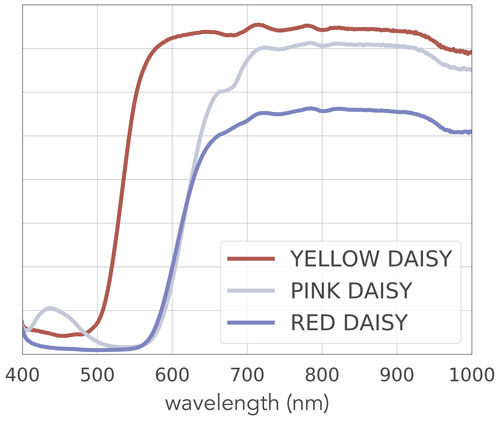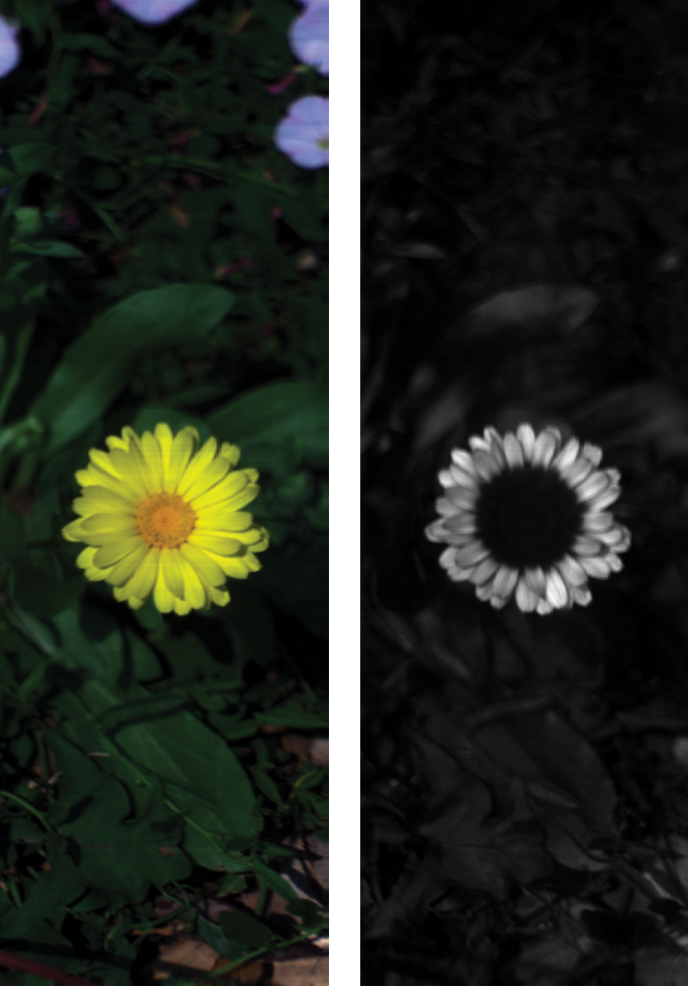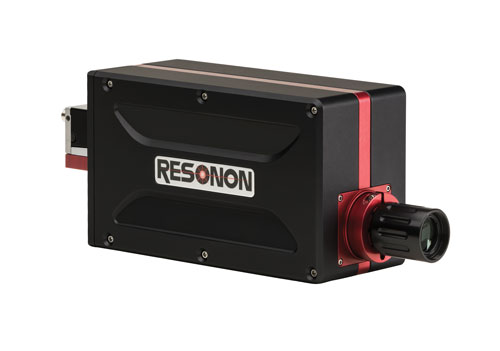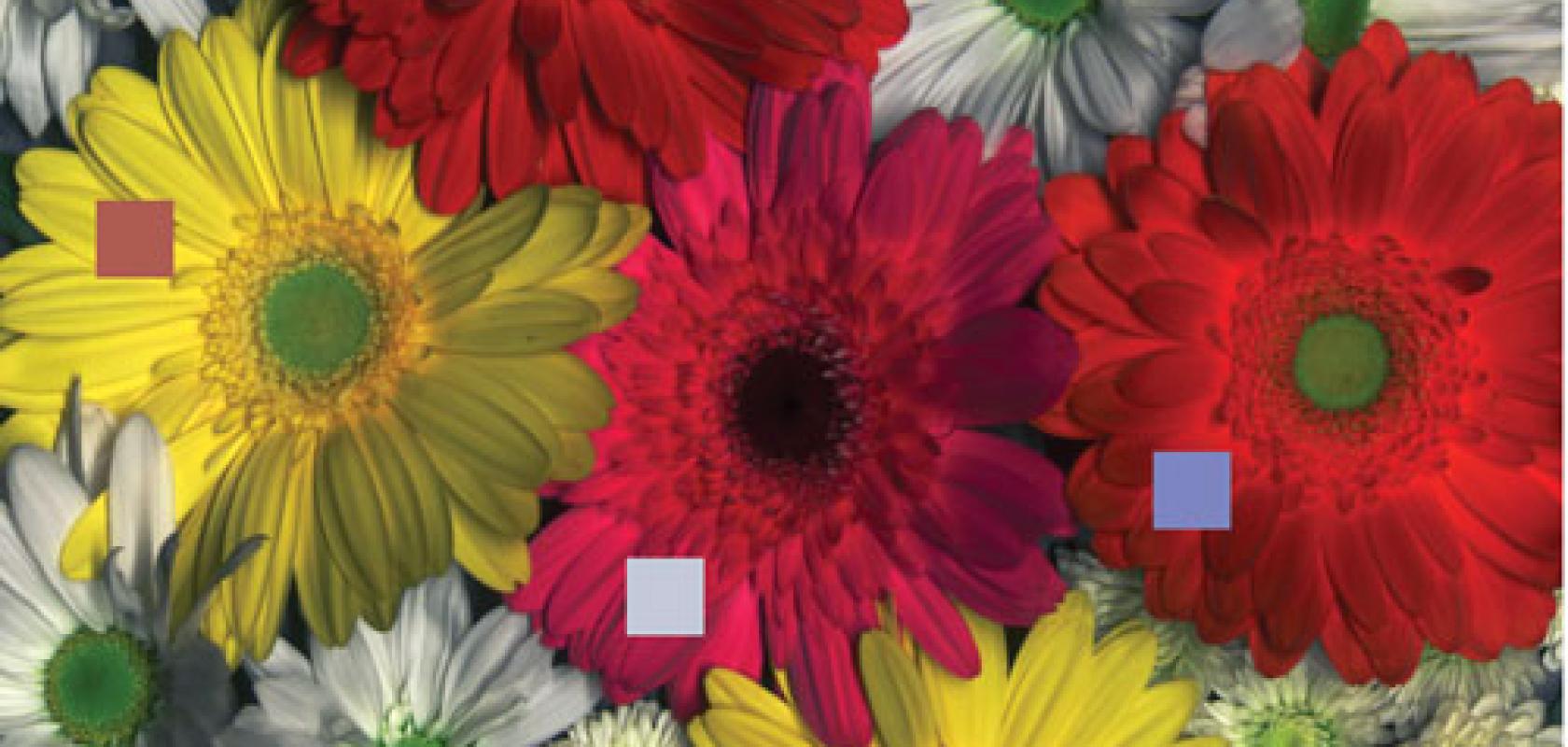Gemma Church investigates how hyperspectral cameras are unlocking new research in the near-UV range
Hyperspectral imaging is a growing field and we're starting to see the potential of imaging at the near-ultraviolet range, thanks to a new system from Resonon.
Most hyperspectral cameras scan across the visible and into the near-infrared or near-ultraviolet ranges. These systems can be used across a range of academic and industrial remote sensing applications. But the goal of such systems is always consistent: to obtain a wide spectrum of light for every pixel, instead of just assigning the primary colours of red, green and blue.

Hyperspectral data of gerbera daisies taken with a Resonon Pika XC2 hyperspectral camera. An RGB true-colour rendering of the data is above, while the graph shows the reflectance of the three square regions in the image
To achieve this, the light striking each pixel is broken down into different spectral bands. This is done using hyperspectral sensors, which collect this information as a set of images, each one representing different bands in the electromagnetic spectrum. This set of images is then combined to form a hyperspectral data cube, which is processed and analysed to create the spectral data.

Image of a calendula flower captured by a Resonon Pika NUV2 hyperspectral camera. The left image shows a true-colour rendering of the data, and the right image shows the intensity of the UV spectral band centred at 360nm
Hyperspectral imaging provides both 2D spatial images and this important spectral information, creating a unique colour signature for individual objects. This imaging information can be used across a wide range of applications.
Resonon designs and manufactures hyperspectral imaging systems and custom hardware and software solutions. Its hyperspectral cameras use line-scan technology across the visible, ultraviolet and near-infrared spectral ranges. They are used across a range of laboratory, outdoor and remote sensing applications, as well as machine vision and optical sorting.
Adam Stern, a senior scientist at Resonon, said: 'Resonon hyperspectral cameras are used for research worldwide, particularly in agriculture, food science, forestry, ocean science, environmental monitoring and medical imaging.
'With high-precision data and best-in-class spectral resolution, our instruments are rugged, reliable and easy to use, and we provide excellent support,' Stern added.
Recently, for example, the company partnered with Nasa to design and build the Arcstone hyperspectral instrument to calibrate lunar reflectance from a low-Earth orbit. This work will help to increase our understanding of the Earth, including its weather and climate change systems, while reducing future imaging satellite costs and improving calibration accuracy by more than 10 times.
Founded in 2002, Resonon also has a range of terrestrial-focused projects. The Resonon Pika L hyperspectral imager, for example, was used to monitor the health of grapevines across the visible and near-infrared spectral range. It provided a non-destructive, fast and information-rich method to reflect crop conditions visually, in a way that is easy to understand.
The Pika NIR-C-320 was also recently used to study the structure and temperatures of an 11,000-acre wildfire, burning just three miles from the Resonon facility in September 2020. Thankfully, no one was injured, but 24 homes were lost and Resonon's systems provided valuable information on this natural disaster.
But it's the company's work at the ultraviolet end of the spectrum that's now unlocking new, exciting applications and research opportunities.
Going UV
The Pika NUV2 camera scans the visible and near-ultraviolet (VIS+NUV) spectral range from 330 to 800nm, with an objective lens optimised for ultraviolet imaging. 'It is currently the only ultraviolet and visible hyperspectral camera commercially available. This is a very unique product,' according to Stern.
The significance and benefits of the Pika NUV2 camera are clear, according to Stern, who added: 'It is difficult to design or manufacture hyperspectral cameras that measure UV light. The sensors have to be responsive to these wavelengths, and the optics need to transmit these wavelengths.
'Most standard lens materials do not transmit below about 350nm and measuring wavelengths below [that] requires special types of glass. Furthermore, non-linear dispersion indices at low wavelengths make distortion control very challenging.
'Through advanced design and fabrication methods, the Pika NUV2 successfully overcomes these issues.'

The Resonon Pika NUV2 hyperspectral imaging camera
The Pika NUV2 system provides unique ultraviolet imaging capabilities, using 255 spectral channels per line with 1,500 spatial pixels per line. It also features a spectral bandwidth of 1.84nm and an FWHM spectral resolution of 02.8nm.
The Pika NUV2 system can be used in the company's off-the-shelf airborne, laboratory and outdoor hyperspectral systems. Resonon also offers a NUV lighting module to augment illumination for its laboratory/desktop systems, helping to further improve the output of the Pika NUV2 camera.
When used in one of the company's systems, Resonon's Spectronon software is included, with real-time deep learning software available for machine vision applications. Alternatively, the Pika NUV2 system can be integrated into existing machine vision systems using the company's software development kit to connect the camera to other, external systems.
In the company's latest White Paper, Resonon explains how the Pika NUV2 camera was used to capture spectroscopic images of flowers, revealing UV reluctance signatures that are not detectable with human vision alone.
Stern said: 'Detecting harmful algae blooms is an exciting new topic for hyperspectral imaging. Animal and insect vision is also an exciting new application. The Pika NUV2 hyperspectral camera is an ideal tool for examining optical features that can be detected visually by animals and insects.'
While the typical spectral range for human vision is between 400 and 700nm, many animals and insects can see UV light at wavelengths below the lower 400nm threshold. This UV vision helps these animals locate food, identify mates and communicate with one another.
Bees, for example, are adept at seeing in the ultraviolet end of the spectrum and, as a result, many flowers have evolved and use colourful patterns only visible in this area of the spectrum to attract the bees' attention.
The Pika NUV2 camera was used to measure the reflectance of calendula flowers, incorporating the company\'92s outdoor rotation system.
'This points to the usefulness of UV imaging spectroscopy as a potential research tool in fields such as botanical science, entomology and ornithology,' Stern concluded.
David Gibson, managing director of Photon Lines, Resonon's partner for the UK, Ireland and the Iberian Peninsula, stated: 'We have been working very successfully with Resonon for some years, having sold systems to customers with applications that include food sorting, marine life investigation and wine crop monitoring. We are excited about this new development since it builds upon our ability to offer unrivalled coverage of the electromagnetic spectrum. Our portfolio already includes thermal hyperspectral imaging up to 11 microns, as previously reported in Electro Optics on 26 March 2021.'
For more information on this topic please click here to download a White Paper.


